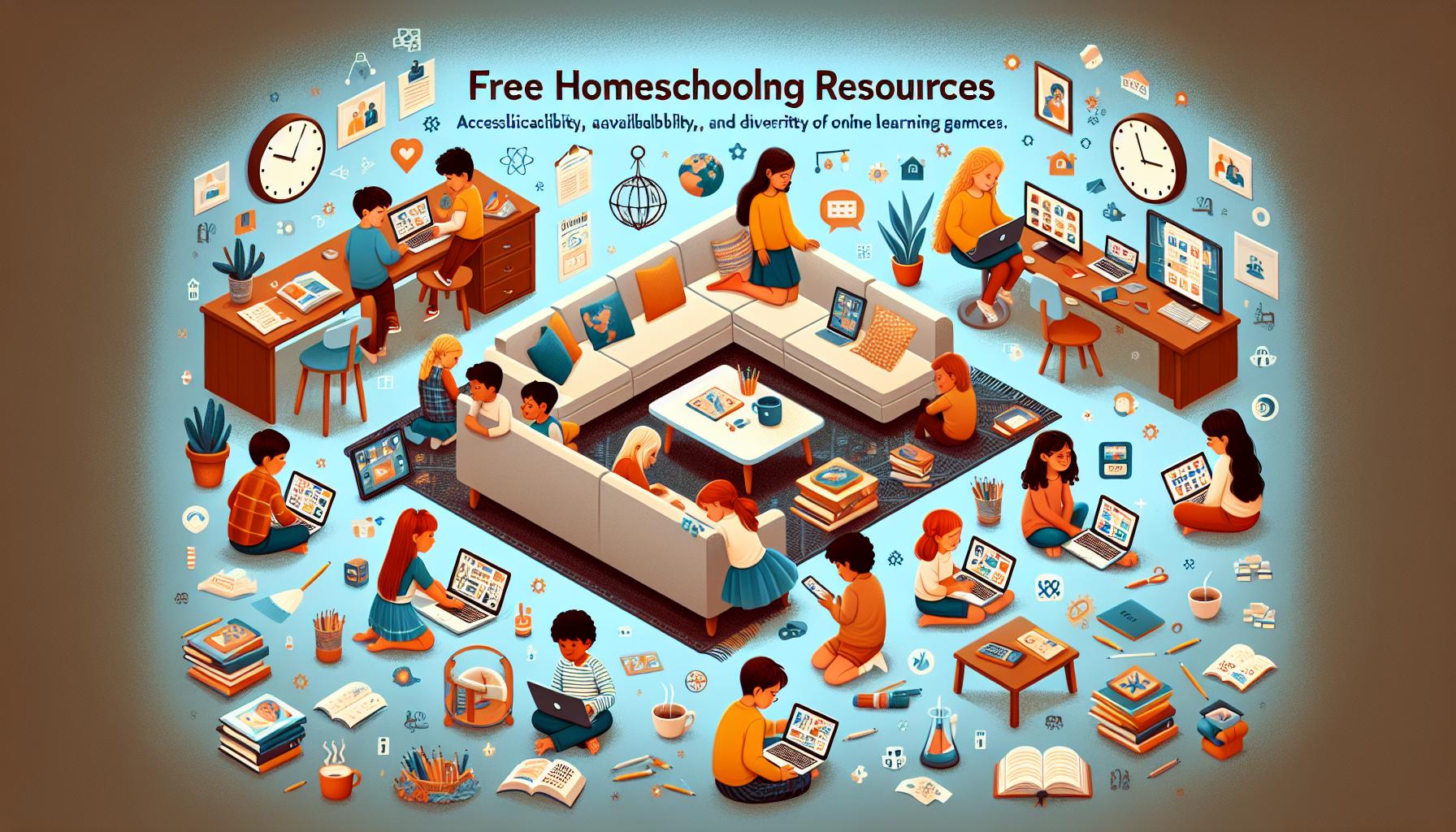
Key Takeaways
- Homeschooling families can access a wide range of free resources, including online curriculums, educational apps, printable worksheets, and virtual field trips, to enhance their child’s learning experience.
- Free homeschooling resources reduce financial burdens, allowing parents to reallocate funds to other educational priorities or extracurricular activities.
- These free tools support diverse teaching methods, personalized learning plans, and increased flexibility to meet individual student needs.
- Community and parent-driven platforms provide valuable insights, sharing practical resources, and offering a space to network with other homeschooling families.
- Organizing resources effectively, setting clear goals, and involving students in the selection process help maximize the benefits of free educational tools.
- Regularly exploring and updating free resources keeps the homeschooling curriculum fresh, engaging, and aligned with academic goals.
Homeschooling offers families the freedom to create a learning environment that fits their needs, but finding quality resources without breaking the bank can feel overwhelming. With so many options out there, how do we know where to start or what will truly support our children’s education?
We understand the challenges of balancing budgets while providing meaningful learning experiences. That’s why exploring free homeschooling resources can be a game-changer. From creative lesson plans to interactive tools, there’s a wealth of options available to help us teach effectively without spending a fortune.
What if we could access materials that inspire curiosity and foster growth without added costs? Let’s dive into the possibilities and discover how free resources can transform our homeschooling journey.
Benefits Of Using Free Homeschooling Resources
Free homeschooling resources support families by reducing financial burdens. They enable access to high-quality educational materials without creating additional costs. Parents can allocate saved funds to other priorities like extracurricular activities or learning tools.
These resources also provide access to diverse teaching methods and subjects. Parents can explore lesson plans, interactive activities, and online tools covering a wide range of topics. This variety helps meet individual student needs and keeps engagement levels high.
Flexibility increases significantly through free options. Families can adapt educational plans to current interests or academic goals. This approach makes learning more personalized and effective.
Collaboration opportunities expand when using group-focused materials. Free webinars, forums, and virtual communities offer connections with other homeschooling families. These platforms allow exchanging ideas, building support systems, and sharing challenges.
Free resources encourage creativity. Parents and students can experiment with different approaches to discover what works best. This fosters a dynamic learning environment where curiosity thrives.
How do these advantages resonate with your homeschooling experience? What specific areas of your curriculum could benefit from free tools?
Types Of Free Homeschooling Resources

Accessing free homeschooling resources can simplify teaching at home and provide engaging learning opportunities for students. Let’s explore some types of resources that can make homeschooling both effective and enjoyable.
Online Curriculum And Lesson Plans
Free online curriculum and lesson plans offer ready-to-use materials for various subjects and grade levels. These resources often include structured guides, day-to-day plans, and detailed instructions. Platforms provide content for math, science, language arts, and history. Some even offer multi-grade options, allowing families with multiple children to streamline teaching efforts.
How do you currently organize lesson plans? With these resources, it’s possible to focus more time on hands-on learning and less on preparation.
Educational Apps And Tools
Educational apps bring interactive learning into homeschooling. Many free apps focus on specific skills like reading fluency, basic arithmetic, or coding, helping children practice through engaging formats like puzzles and games. Digital tools, including flashcard apps and typing software, support skill-building across age ranges.
Are there particular skills your child is struggling with? Free apps give us opportunities to address gaps in a fun and accessible way.
Printable Worksheets And Activities
Printable worksheets and activities allow for offline learning and reinforce key concepts. Many websites offer subject-specific worksheets, such as grammar drills or multiplication tables. Activities like science experiments and art project guides often come with step-by-step instructions, adding variety beyond traditional lessons.
Do you use hands-on activities to keep learning fun? These printables can help us add creativity to our daily routines.
Virtual Field Trips And Videos
Virtual field trips and educational videos bring real-world experiences to homeschooling. From exploring historical landmarks to watching live animal cams, these resources introduce new perspectives while staying home. Platforms offering free documentaries or engaging topic-based videos can also deepen understanding in subjects like geography or biology.
What sparks your child’s curiosity? Virtual tours could inspire interests we hadn’t yet considered.
Top Websites Offering Free Homeschooling Resources

Accessing free homeschooling resources online can simplify lesson planning and support diverse educational needs. We’ve highlighted websites offering robust materials to empower families with cost-effective tools.
Government And Non-Profit Platforms
Public resources provide quality educational content aligned with academic standards. Many government websites host free curriculum content, activities, and educational tools. These platforms often organize materials by grade and subject, helping parents find relevant lessons quickly. Non-profit organizations frequently share free resources, such as e-books, lesson plans, and learning activities, promoting equal access to education.
Some examples include virtual science experiments, geography games, and math exercises that engage students while strengthening essential skills. These platforms often include accessibility features, ensuring every learner can participate. Have you explored how government or non-profit resources could add value to your homeschooling routine?
Community And Parent-Supported Sites
Parent-driven platforms bring valuable insight into practical homeschooling strategies. Many community-focused websites offer free learning materials created and shared by experienced homeschooling parents. These resources range from printable worksheets and interactive lesson plans to detailed unit studies across various subjects. Discussion forums and support groups often accompany these platforms, providing opportunities to connect with other homeschooling families.
For instance, parents commonly upload resources like reading comprehension activities, sample science projects, and history timelines that have worked well in their own homeschools. Feedback from these communities helps refine approaches and identify effective tools. What solutions might you discover by engaging with supportive homeschooling communities?
Tips For Organizing And Using Free Homeschooling Resources
Set Clear Goals
Planning starts with identifying your educational priorities. Decide which subjects or skills are most important for your child to focus on. What outcomes do you want from the resources you use? Having defined goals helps you choose materials that align with your child’s needs and prevents wasting time on less effective tools.
Categorize Resources
Organize materials by type or subject. For example, group video lessons, printable worksheets, or science activities into dedicated folders or files. Digital files can be stored in labeled cloud folders, while physical worksheets may go into color-coded binders. This categorization streamlines access and reduces frustration when lesson planning.
Create a Weekly Plan
Draft a weekly schedule based on available resources. Include a mix of activities, such as hands-on projects, reading, and online lessons, to keep learning dynamic. Write out sessions for each subject, prioritizing core areas like math and reading while incorporating creative pursuits. A flexible plan lets you adjust if new resources or interests arise.
Track Progress
Use a simple checklist or spreadsheet to monitor completed lessons and skill development. Mark off each finished worksheet, activity, or video. Tracking helps identify what’s working well and highlights areas needing additional focus. Regular reviews keep learning on the right path.
Set Time for Exploration
Allow dedicated moments to explore new free resources. Schedule a monthly search to see what’s recently available, such as free webinars or updated lesson plans. This practice keeps the curriculum fresh and engaging.
Engage Your Student
Ask your child for input when selecting resources. Let them share preferences about activities or subjects they enjoy. Involving them fosters enthusiasm for learning and ensures the curriculum resonates with their interests.
Network with Other Homeschoolers
Join online forums or local groups to share insights. Fellow homeschooling parents often recommend free tools or effective teaching strategies. Participation in community discussions can introduce you to materials that match your goals.
Evaluate Resources Regularly
Not all free content remains relevant. Review materials periodically for outdated information or a lack of alignment with grade levels. Replace less effective resources with newly found ones to optimize your child’s education.
Conclusion
Free homeschooling resources open up endless possibilities for creating a personalized, engaging, and cost-effective learning experience. They empower us to explore diverse teaching methods, connect with like-minded families, and adapt our approach to fit our unique goals.
By embracing these tools, we can make homeschooling more dynamic and enjoyable for both parents and students. Let’s continue to discover and share these valuable resources to build a thriving and supportive homeschooling community.
Frequently Asked Questions
What are the main benefits of homeschooling with free resources?
Homeschooling with free resources allows families to save money while accessing high-quality educational materials. It provides flexibility to tailor learning to a child’s interests and needs and supports dynamic learning through creative lesson plans, interactive tools, and various teaching methods.
Where can I find free homeschooling resources?
Many government and non-profit websites offer free resources aligned with academic standards. Parent-supported platforms and online communities also provide printable worksheets, lesson plans, and interactive materials. Additionally, websites like Khan Academy and YouTube have free educational content for various subjects and grade levels.
How can I organize free homeschooling materials effectively?
Start by setting clear educational goals. Categorize resources by type or subject and create a weekly plan that mixes activities like lessons, hands-on learning, and videos. Use checklists to track progress, and regularly evaluate resources to ensure they meet your objectives.
Are virtual field trips helpful for homeschooling?
Yes, virtual field trips provide an engaging way to explore real-world experiences from home. They spark curiosity, enhance learning, and make subjects like history or science more interactive and exciting for students.
How can I make my homeschooling plan more flexible?
Incorporate varied resources, like online tools, printable worksheets, and interactive apps, to allow adjustments based on your child’s interests or learning pace. Flexibility ensures you can adapt to unique academic goals or explore new topics that arise.
What types of free resources are best for younger children?
For younger children, printable worksheets, hands-on activities, and educational apps with interactive elements are highly effective. Platforms offering videos or songs for literacy and numeracy skills are also great for keeping younger learners engaged.
What are online communities for homeschooling and why are they valuable?
Online homeschooling communities connect parents and educators for support, sharing tips, and resource recommendations. They provide discussion forums, free webinars, and group-focused activities, making them valuable for collaboration and motivation.
How can I keep my child engaged while homeschooling?
Incorporate interactive activities like games, apps, and videos, and allow your child to help choose learning materials. Exploring creative lesson plans and hands-on projects can keep learning exciting and maintain their interest.
Are free resources as good as paid ones?
Many free resources are high-quality and meet academic standards. They often include structured lesson plans, engaging tools, and diverse teaching methods comparable to paid options, making them an excellent choice for budget-conscious families.
How often should I evaluate my homeschooling resources?
Regularly, perhaps once a month or a semester. This ensures the materials remain relevant, effective, and aligned with your educational goals, allowing for adjustments as your child’s needs or interests change.

